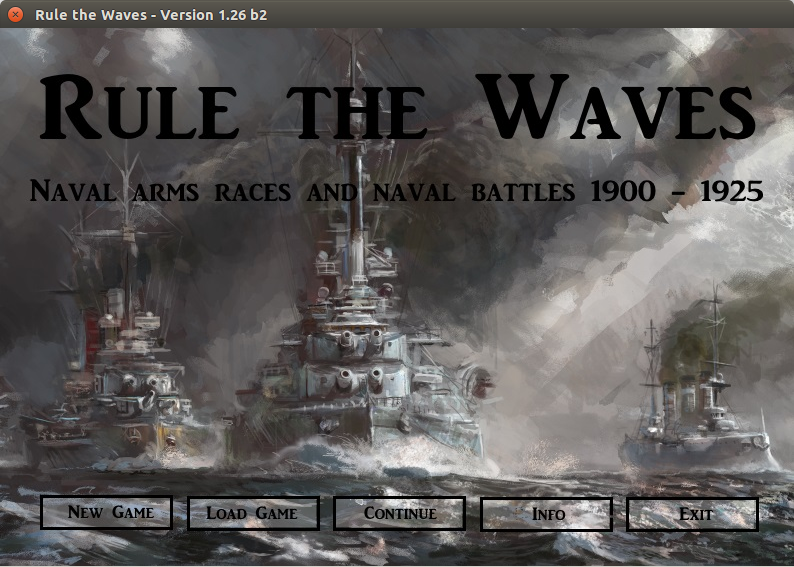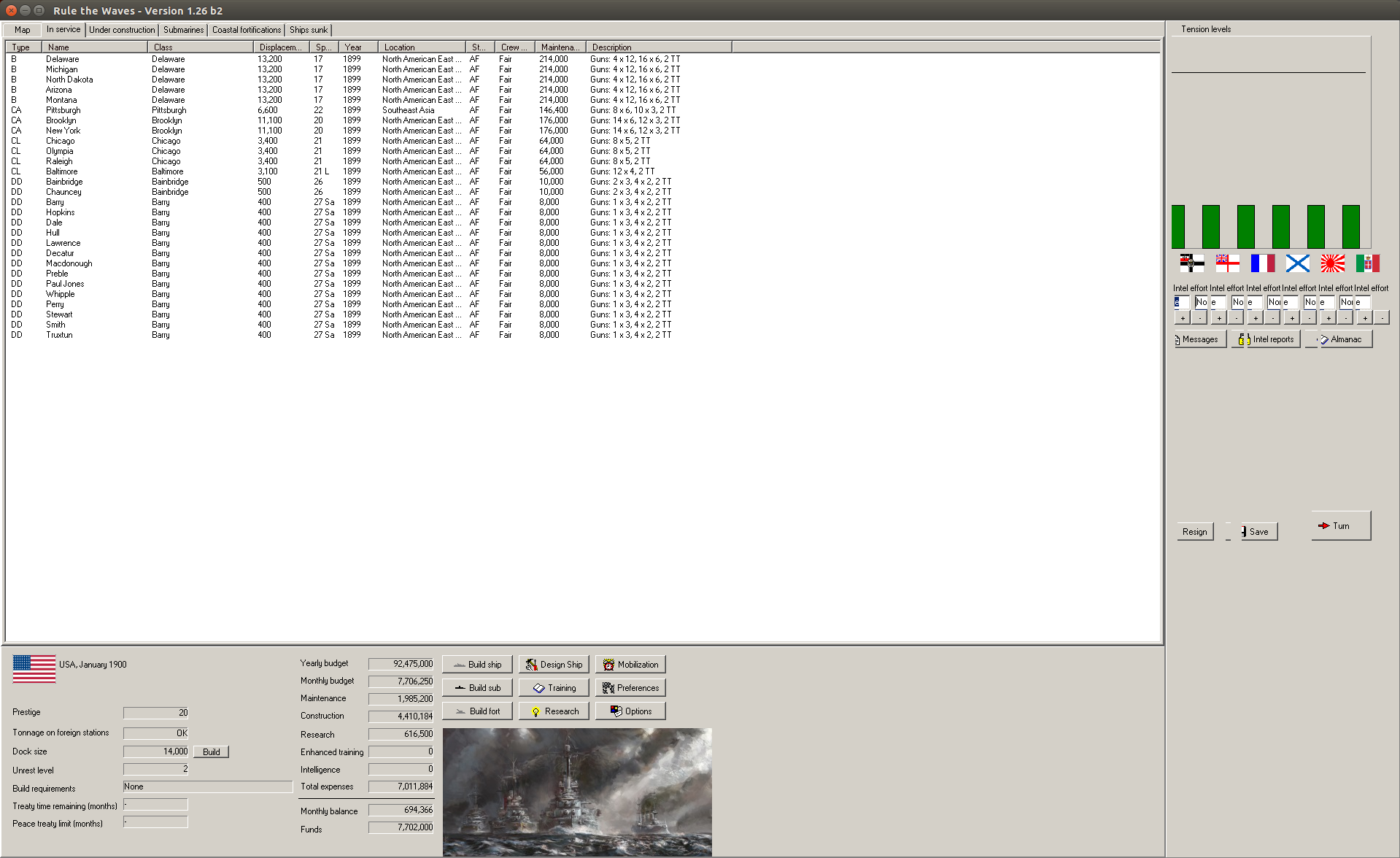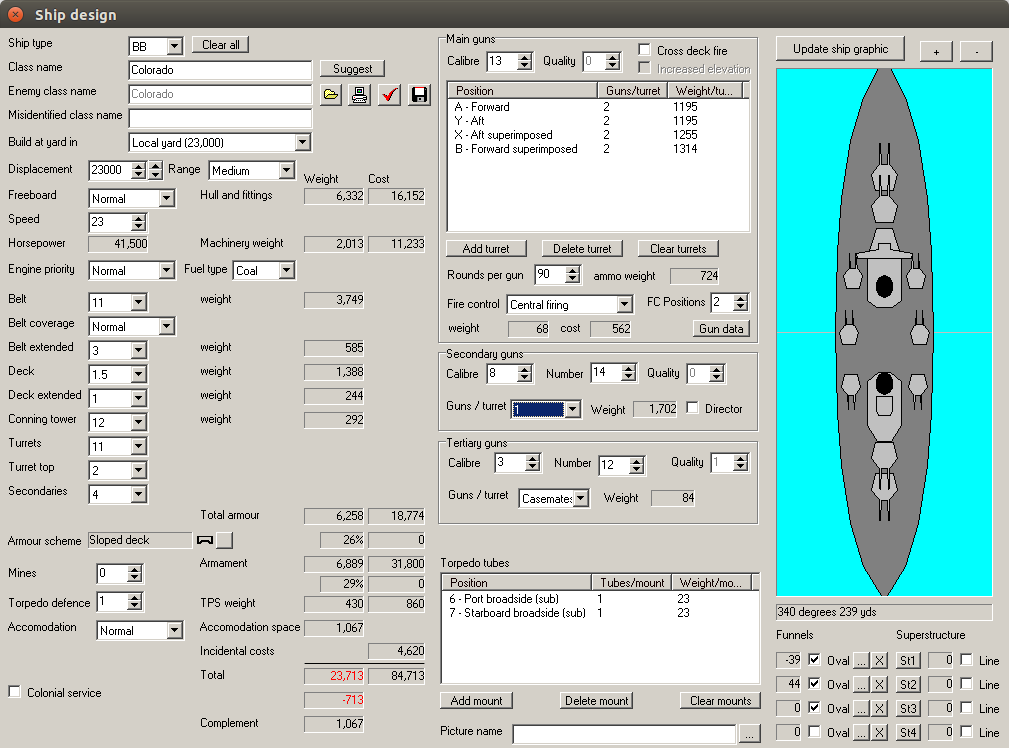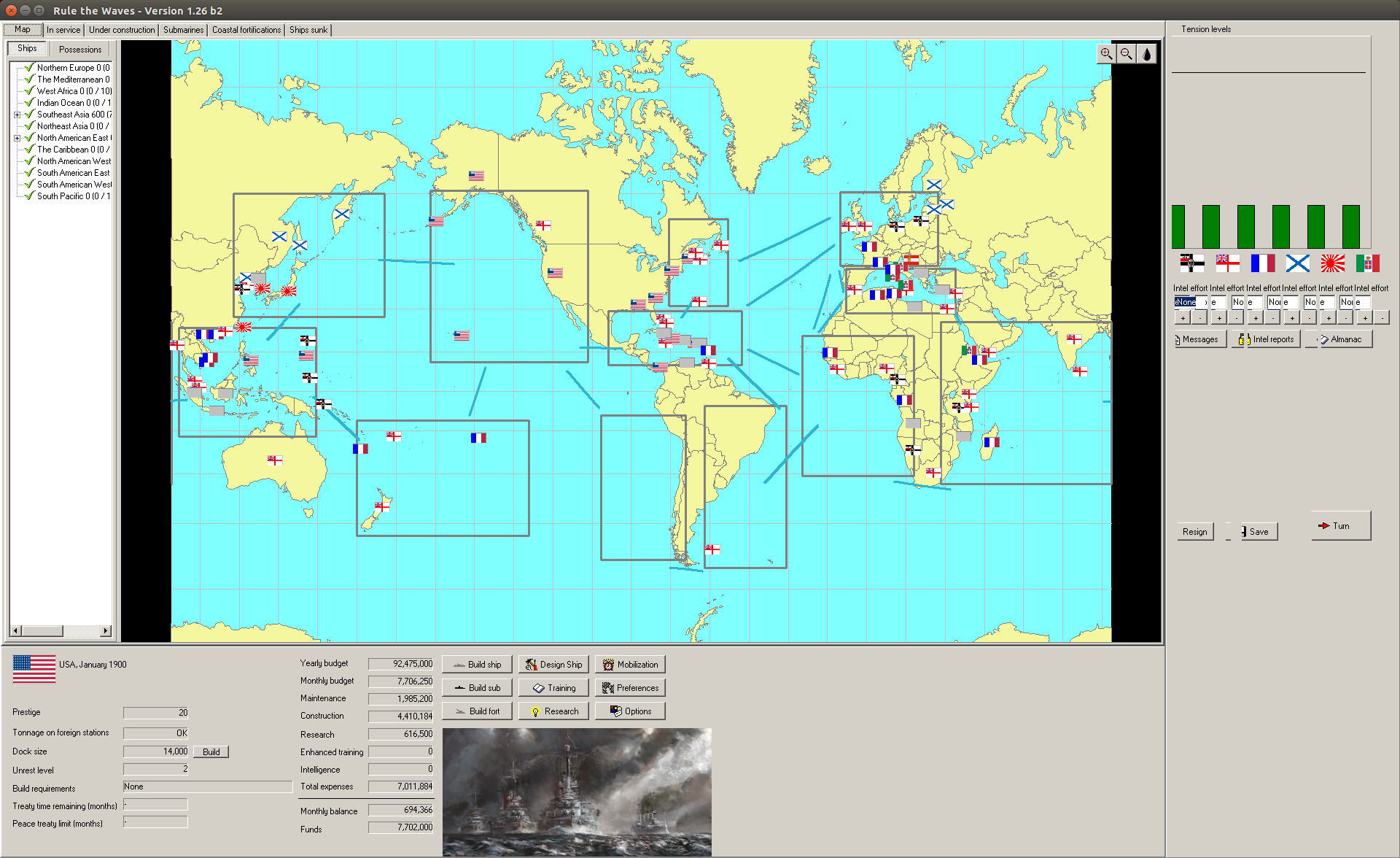“Rule the Waves”: a unique, compelling game of naval strategy
 Dear strategy gamers, I want to tell you about a little diamond in the rough I came across the other day. Its name is Rule the Waves, and you should be playing it.
Dear strategy gamers, I want to tell you about a little diamond in the rough I came across the other day. Its name is Rule the Waves, and you should be playing it.
Naval Warfare Simulations, the creators of Rule the Waves, describe it as “a game of naval ship design and combat at the birth of the 20th century.” But that really doesn’t do it justice. If you really want to get the flavor of what Rule the Waves does, think of it instead as Armageddon Simulator.
Let’s start with a little historical background
Though people didn’t really think of it this way at the time, at the end of the 1800s, the European system started breaking down. Germany had finally been unified from a collection of minor states into one huge nation, and the emergence of this new giant in the heart of Europe threw long-standing power arrangements into disarray.
Having defeated its main continental adversaries, France and Austria, on land, in the 1890s the Germans began to flex their muscle in a new arena: the sea. The mostly-landlocked German states had never been naval powers, but led by the navy-mad Kaiser Wilhelm II and his top naval advisor Alfred von Tirpitz, the new Germany embarked on a massive program to build a navy that could challenge the traditional ruler of the seas, Great Britain.
As an island nation that required overseas trade for nearly all its raw materials, including such necessities as food and oil, Britain was naturally alarmed by this development. A Germany that dominated continental Europe was a Germany the British could live with; a Germany that could choke off Britain’s trade routes was not. So they stepped up their own shipbuilding to meet the German challenge, kicking off a ruinously expensive arms race that didn’t end until the two countries finally went to war in 1914.
In the end, all that battleship-building had no real effect on the outcome of the war; the two fleets clashed a few times, but the “decisive battle” — the titanic struggle of battleships that the hugely influential contemporary naval theorist Alfred Thayer Mahan had predicted would decide any future war — never really came. Both nations had spent so much money on their battle-fleets that they could never bring themselves to put them fully at risk. It was a classic example of military spending becoming uncoupled from strategic reality.
Unleashing your inner Tirpitz
What Rule the Waves does is put you into the shoes of Tirpitz, or any of his contemporaries in other great powers — Jacky Fisher in Britain, Louis-Émile Bertin in France, William Sims in the United States, and so on — right at the moment that great naval race is about to begin. It then becomes your responsibility to steer the development of your nation’s navy until the year 1925, or until you’re driven from office in ignominy, whichever comes first.

Rule the Waves’ main interface screen, showing a typical auto-generated U.S. Navy “legacy fleet” in 1900
In practice, what this involves is building and managing a fleet. You start off in the year 1900 with a fleet of “legacy ships,” built to the standards of 1899. These will suffice for a few years, but each month-long turn brings news of new technical advancements in shipbuilding — advancements that allow the construction of new ships which can easily blow your legacy fleet out of the water. You have to keep up with these developments, choosing when to build new ships, how many to build, and which of the new technologies to incorporate into them.
Which brings us to one of your primary tasks in Rule the Waves: designing new ships.
As your boffins unlock new technologies, or as you buy them from other powers looking for some quick cash, frontiers in shipbuilding that were previously closed to you begin to open up. Early battleships may come with 10″ guns, but research can let you build up to 18″. Machinery becomes lighter and more powerful, letting you add more armor or artillery without paying a penalty in speed. New aiming mechanisms let your gunners land their shells with increased precision. And so forth.
But what makes all this a game and not just navy porn is that you have to figure out to put all this hardware to use while operating within some very powerful constraints. You have a budget, for example, given to you by your government, which specifies how much you can spend in a given year. You can choose to ignore it and operate at a deficit if you want; but if you do so for too long the head of government will tire of your free-spending ways and fire you, which means Game Over. So you find yourself constantly having to choose between competing priorities, since there’s never enough money available to pursue them all. Do you build a small number of huge mega-battleships, or a larger number of smaller ones? Should this cruiser be optimized for speed, for armored protection, or for firepower? Should you be building submarines, or destroyers you’ll need to defend your coasts from an enemy’s submarines?
Another constraint in Rule the Waves is time. You can design any type of ship you want (within the limits of your available technology at that moment, of course), but once you approve the design for production it can take months or even years for ships built to that design to start coming off the ways and into your fleet. And all that time you’re waiting for construction to complete, technology is still marching on — meaning that it’s very possible for a new class of ship to be made obsolete by technical developments before it ever sees its first day at sea. So at all times you have to ask yourself, is now the moment to pull the trigger on this new design and send it off for production? Or should I wait a few more months and hope to get one or two more big new advances in first?
Beyond new building, though, there’s your existing fleet to manage as well. The rapid pace of technical innovation means that the ships you actually have at any given moment are sliding closer to outright obsolescence every month; and keeping a ship on the roster costs money for upkeep and maintenance. So another question you’re always asking is, at what point does the cost of maintaining a ship outweigh its usefulness? Even completely obsolete ships can still have value, after all; old destroyers can still perform anti-submarine patrols, old cruisers can still sink unarmed enemy merchantmen, old battleships can be sent to remote colonial stations to “show the flag” and maintain your authority there. They can all serve in such capacities perfectly well, and spare you the trouble and expense of building up new ships to replace them — so long as they never cross the path of a modern, well-armed battlecruiser in wartime…
Interestingly, Rule the Waves gives you some options to extend the lives of your older ships alongside all the tools you have for building new ones. Any design that’s gone into production can be re-opened in the editor for modification at any time, though the changes you can make to it are limited somewhat by the ship’s existing size. Even with that, though, taking an existing ship and refurbishing it can be a quick way to upgrade your fleet, since rebuilds take less time and cost less money to turn around than building a new ship from scratch does. But you can only push a rebuild so far, so you’re constantly having to evaluate whether rebuilding or scrapping-and-replacing is the right move for that particular moment.
The inevitable clash of steel
All of this is what occupies the Rule the Waves player during peacetime. Eventually, though, war breaks out — and suddenly all your theories and plans are put to the test of fire.
War in Rule the Waves is not tied to war in actual history; there’s no fixed rule that it will break out in August 1914 and end up roping in the whole world. What happens instead is that your nation has a “tension” level with all the other nations in the game, and that level fluctuates based both on how aggressively you are building your fleet and how you choose to respond to events that pop up from time to time.
The fleet-building part of this equation is pretty straightforward; if you start building a fleet big enough to overwhelm someone else’s fleet, they get nervous, and if you push in that direction hard enough for long enough they’ll start wondering if they should just hit you today while that fleet is still a-building. The events, though, provide a fun wildcard. As you’re moving from turn to turn, the game will periodically throw up news of some development — the President said something stupid about France, for instance, or the dovish party in your legislature is pushing to cut naval expenditures to fund social programs, or your spy in Germany has gotten himself caught. Each of these comes with a set of options for how to respond, from which you have to choose one.
So far, so simple. But what’s interesting about those options, though, is that they generally force you to choose between tension — that nervousness other nations feel about your ambitions — and prestige, the value that keeps you from getting fired. So you can choose to be diplomatic and conciliatory, which will reduce tension but also chip away at your prestige; or you can choose to be bellicose and blustery, which raises your prestige at the cost of alarming the rest of the world. (Your budget is partly driven by your prestige as well, so caution and reserve can also be a good way to hamstring your building program.) This mechanism feels very true-to-life, and helps illustrate the dynamics that could drag the nations of the era into disastrous wars that nobody really wanted to fight.
When war comes — and it always comes, eventually — you have to take your lovingly designed fleet and send it out into the world to challenge your opponent.
Rule the Waves divides up the world into a number of sea zones, each of which serves as a potential theater of conflict. Around each sea zone are scattered possessions, land territories that can serve as bases for ships.
Possessions are the axis around which warfighting in Rule the Waves revolves. If you send enough ships into a sea zone where your opponent holds possessions to overmatch their local force, your nation’s army can use that local superiority to land troops and seize those possessions from them, bringing them under your flag instead. But the enemy, of course, can do the same thing to your possessions. So in each war you have to decide at a high level whether to strike an offensive posture, trying to grab possessions from the enemy, or a defensive one, keeping them from taking any from you.
High-level decisionmaking isn’t enough, though, because no matter how feverishly you build, there’s never enough ships on hand when war breaks out to cover the whole world at once. So now you have more decisions to make: do you concentrate your fleet in one or two sea zones to maximize its striking power, or spread it out to try and protect all your possessions? Do you keep your heavy hitters, the battleships and battlecruisers, together in one flotilla, or break them up into battle groups of one or two capital ships with an escort of smaller ships for scouting? Do you want to try and win by crushing your enemy’s fleet in a Mahanian “decisive battle,” or by starving them into submission by sinking their merchant fleet — and, if it’s the latter, will you do it by sending ships off to hunt on their own as commerce raiders, or by massing your fleet in their home waters to blockade them?
However you end up deciding these things, however, at some point your ships are going to meet the enemy’s.
At which point Rule the Waves drops you into a top-down tactical interface, where you can lead your ships into battle yourself. Based on NWS’s earlier standalone game Steam & Iron, this mode lets you direct your ships by maneuvering one squadron — the “flag” — while the others maneuver based on how you instruct them to relate to it. So you can set up a long battle line, for example, by giving squadrons orders to follow the next in line, or send your light ships out to search for targets while the slower “core” with the big guns hangs back.
If you’re able to find the enemy — not always guaranteed in this age before radar, especially if you’re fighting at night — you have to maneuver your fleet to defeat them. This generally turns into a game of cat and mouse; heavier ships generally have the advantage in firepower and armor, but faster, lighter ships can more easily skitter out of range. If you’re the one with the big guns on your side, your goal therefore is to pin your opponent’s ships down and pummel them, while on the other side the goal is to escape and evade.
While you can have some effect on which of those sides you end up on through your choice of which ships to send into a particular sea zone, it’s not entirely within your control; the game usually only drops a portion of each side’s available forces into a given scrap, to simulate the difficulty of coordinating entire fleets of ships in an age before reliable ship-to-ship radio communication. This can lead to some lopsided fights, but in general it does a good job of balancing the sides. And since most battles only draw in a fraction of your forces, when you hit a battle where each side actually brings its complete battle line to bear, it’s kind of awesome.
Wars can end a number of different ways. They can sputter out indecisively, with the combatants just deciding it’s not worth it anymore; they can climax in a great fleet battle, leading to the loser surrendering some of their possessions; or if the war drags on long enough and bites deep enough, they can even end with one nation collapsing completely through a popular revolution. (Which you can sometimes help along by smuggling an exiled revolutionary back into their homeland.)
Then the world goes back to peace, and you go back to building up your fleet for the next war.
Caveats and conclusions
As you have probably been able to surmise from the length and detail of this review, I like Rule the Waves a lot. It’s one of the most interesting and compelling strategy games I’ve ever come across. If you’re a fan of the genre, you really do owe it to yourself to give it a spin.
That being said, it’s not all peaches and cream. For reasons I won’t pretend to understand, NWS has made some decisions that really hobble the “curb appeal” of this otherwise excellent title. Which is a shame, because with just a little more care and attention, what is currently a very niche title could attract a much larger audience.
The first limitation is the quality of the graphics and the user interface, which, as you can see from the screenshots above, are pretty bare-bones. The UI is straight out of the Windows 3.1 era, all vanilla Windows radio buttons and lists and drop-downs. It works, more or less, but it makes it harder to learn the ropes than a more thoughtfully designed interface would. In the main interface, the only graphics are the occasional photograph that’s used to illustrate an event; the battle interface offers animated ships, but they’re presented in the most drab way possible, as blocky black elements on a flat blue sea. Like many titles in the wargaming niche, the production values are just sad when lined up against contemporary mass-audience games — or even mass-audience games from five or ten years ago. There is an amazing game to be found here, but you’d never know it from looking at the screenshots.
Second, the quality of the “onboarding” (ugh, how I hate that word) experience new players of Rule the Waves face is just dire. There are a lot of complicated systems under the hood of this game, which most developers would take as a sign that they need to provide new players with some hand-holding as they learn how they all work. NWS, however, drops you into Rule the Waves with no assistance whatsoever — no online help, no tutorial scenario, no nothing. The only guidance they offer is a disorganized, incomplete PDF manual you have to go to their forums to download. You could get away with throwing new players into the deep end of the pool twenty or thirty years ago, when there were fewer games for them to play; but today people are just awash in options, so the sink-or-swim approach just feels passive-aggressive and lazy.
Finally, the experience of actually buying the game is frustrating as well. You have to go to NWS’ web site, which looks like a Yahoo! store from fifteen years ago, put in your payment information, and then wait up to 24 hours for them to email you an activation code. In an age when you can instantly buy just about any game ever made with two clicks via Steam, NWS’ approach feels downright antediluvian. It’s like doing business with a company that has been frozen in amber for two decades. I have to think putting up all these barriers costs them sales — especially in conjunction with a relatively high list price of $35. Which is a shame when it’s driving people away from a game like Rule the Waves that does so many things right.
So, to summarize: Rule the Waves is hard to buy, hard to look at, and hard to play. But if you’re a strategy gamer you should play it anyway, because the actual game hidden underneath all those problems is so good it’s worth it. There’s tons of interesting gameplay to be had here, even if you’d never know it from looking at the outside. It’s a frog waiting for your kiss to turn into a prince.
Want to read more about Rule the Waves? I wrote a follow-up post on the strategic challenges you’d face playing as each playable nation.



